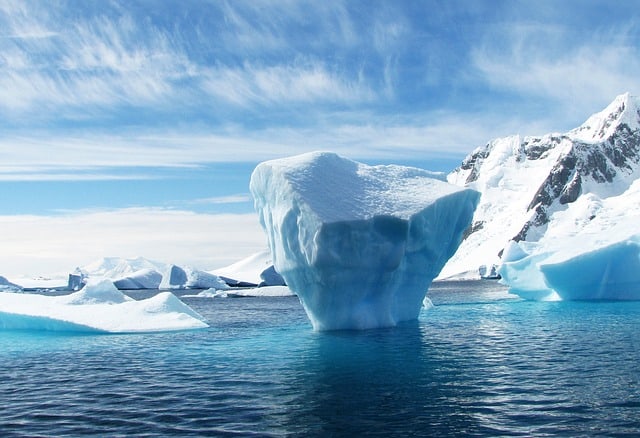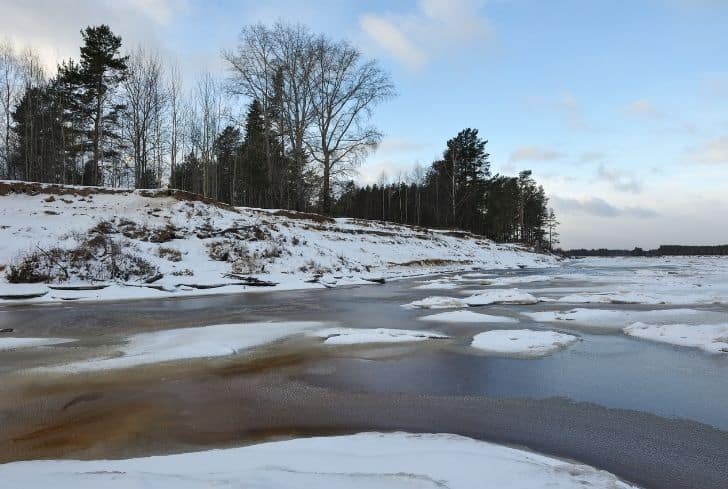Can Clouds Freeze? (And Collide?)

There are many phenomena created around the cloud. Likewise, there are many surprising things about clouds, from formation to precipitation. Let us explore some of those astonishing facts in this article.
What Are the Clouds Made of?
Clouds are made of tiny light water droplets or ice crystals that can stay in the air. The water from the ocean, lakes, and rivers turns into water vapor, the gaseous form of water by evaporation and travels in the air. The water or ice that makes up clouds travels into the sky within the air as water vapor.
When air rises in the atmosphere, it gets cooler because of decreased temperature and lesser pressure of air. When air cools and the corresponding air pressure drops, it can hardly hold as much water vapor as before. Consequently, the vapor transforms into tiny water droplets or ice crystals, and thus a cloud is formed.
Can Clouds Freeze Solid?
Supercooling is the phenomenon behind why water does not freeze in the clouds. It is a state where liquids do not solidify even below their typical freezing point.
According to Wikipedia,
“Supercooling, also known as undercooling, is the process of lowering the temperature of a liquid or a gas below its freezing point without it becoming a solid. It achieves this in the absence of a seed crystal or nucleus around which a crystal structure can form. The supercooling of water can be achieved without any special techniques other than chemical demineralization, down to −48.3 °C (−55 °F).“
Why Do Clouds Not Freeze at High Altitudes?
Clouds at high altitudes accumulate supercooled droplets of water below their freezing point. Supercooled liquids are trapped in a metastable state much below their freezing point, which can only be achieved in liquids not containing seeds that may trigger crystallization.
Clouds at high altitudes contain tiny droplets of water that, in the absence of seed crystals, do not form ice despite the low temperatures.
How Do Clouds Form?
Clouds usually form when the invisible water vapor in the air condenses into visible ice crystals or water droplets. It requires that the parcel of air becomes saturated, i.e., water vapor starts to condense into a liquid or solid form, unable to hold all the water it contains in vapor form. Remember, the warmer the air, the greater the quantity of water vapor it can hold.
On the other hand, reducing its temperature decreases its ability to hold water vapor so that condensation occurs. Therefore, humidity is the amount of water vapor in the air.
Commonly, there are two ways by which the saturation level is reached.
(a) By increasing the water content in the air through evaporation to a point where the air can hold no more.
(b) By cooling the air to reach its dew point, the temperature at which condensation occurs and cannot ‘hold’ any more water.
It is easier for water vapor to condense into water droplets when it has a particle to condense upon. These particles, such as pollen and dust, are commonly known as condensation nuclei. Therefore, water vapor condenses upon pieces of dust, pollen or other condensation nuclei to form a cloud.
Hence, three things must occur for a cloud to form:
- Relative humidity must remain close to one hundred percent,
- Tiny bits of matter, for example, dust, must be present, and
- Something must happen to cool the air.
Depending on how cold the air is and how much water is in the air, different types of clouds are formed. Therefore, there are different types of clouds and different environmental reasons why clouds form. These different clouds are named based on their shape, size and height in the sky.
Clouds indicate or show the current weather conditions and help meteorologists predict near and future weather. In addition, clouds are often associated with precipitation, like rain, sleet, snow, or hail.
Why Do “Frozen Clouds” Not Fall Out of the Sky?
If it is cold enough, clouds are made out of tiny water droplets and ice crystals. However, most clouds’ droplets or crystals are too small to have any appreciable fall velocity. So the particles continue to float with the surrounding air, similar to tiny dust particles that appear to float in the air when viewed against a shaft of sunlight.
Indeed, the radius, the distance from the center of a typical water droplet to its edge, ranges from a few microns (thousandths of a millimeter) to a few tens of microns (ice crystals are often a bit larger). The speed with which an object falls depends on its mass and surface area. For example, a feather falls more slowly than a pebble of the same weight.
Mass is proportional to the radius cubed (r3) for roughly spherical particles; the downward-facing surface area of such a particle is proportional to the radius squared (r2). Thus, as a tiny water droplet grows, its mass becomes more vital than its shape, and the droplet falls faster.
However, even a large droplet having a radius of 100 microns has a fall velocity of only about 27 centimeters per second (cm/s). Moreover, ice crystals having more irregular shapes have relatively fewer fall velocities.
Updrafts, an upward vertical motion in the atmosphere, also contribute to clouds’ floating by offsetting the small fall velocities of their constituent particles. The air moving upward forms clouds and helps them survive and grow.
Rising air expands as the pressure decreases and expands into thinner, high-altitude air, causing cooling. Enough cooling eventually makes water vapor condense to help the survival and growth of the clouds.
Stratiform clouds typically form in an environment with a widespread but weak upward motion that produces steady rain (say, a few cm/s); convective clouds are associated with updrafts that exceed a few meters per second, causing showers and thunderstorms. However, the atmospheric ascent is sufficient to negate the small fall velocities of cloud particles in both cases.
The relative lightness of clouds can be compared between the total mass of a cloud and the air in which it resides. For example, consider a hypothetical but typical small cloud at an altitude of 10,000 feet, comprising one cubic kilometer and having a liquid water content of 1.0 gram per cubic meter.
The total mass of the cloud particles is about 1 million kilograms, roughly equivalent to the weight of 500 automobiles. On the other hand, the total mass of the air in that same cubic kilometer is about 1 billion kilograms which is 1000 times heavier than the liquid.
Though typical clouds contain much water, this water is spread out for miles in the form of tiny water droplets or crystals. Being so small, the effect of gravity on them is negligible. Thus, clouds seem to float in the sky from our vantage on the ground.
Can it Snow Without Clouds?
Snow can fall out of the maximum clean and clear blue sky, having no intervening clouds at freezing temperatures, 40 below zero (C or F) and colder. Temperatures need to be very cold that the water vapor deposits on dust or other minute particles in the air.
When condensation nuclei are present, the weather condition known as diamond dust may form at temperatures below minus 20 degrees C (0 degrees F). At these low temperatures, the water vapor in the air spontaneously forms ice crystals that slowly settle towards the earth. These falling crystals, when caught in the light, sparkle like gemstones.
Usually, ice crystals form either as unbranched ice needles or as irregular hexagonal plates or ice columns directly from water vapor in the air. The formation of hexagonal-plate crystals is possible at temperatures from minus 10 degrees C to minus 20 degrees C (14 degrees F to minus 4 degrees F).
Ice plates resemble dinner plates with a hexagonal pattern in their long dimensions and are thin relative to their width. On the other hand, ice columns look like minute stubby pencils. Columns typically form in temperatures below minus 25 degrees C (minus 13 degrees F).
Do Clouds Collide?
Clouds do not collide. If you look at the sky and find two clouds moving toward each other, you may think they will collide, but they are at different elevations and are vertically separate by a reasonable distance.
If two clouds are next to each other, they will be affected by the same winds and move in the same direction. They merge because the wind pushes them together. Not much happens since each cloud is only about 2% water. As a result, you get a bigger cloud.
Now two clouds can “connect,” or a cloud can “break apart” into multiple clouds. There is nothing unusual about this since clouds are not objects but condensed water droplets in the air. In addition, humidity between two nearby clouds is similar to that inside the two clouds, so getting this area to condense into the cloud is possible.
A growing cloud-like cumulonimbus that is expanding in all directions will incorporate clouds in the path of the expansion itself. Furthermore, a cloud that loses moisture due to rain will eventually break into pieces where moisture is still high enough to sustain condensation only in those pieces.
Are Clouds Ice or Water?
Clouds consist of millions of tiny water droplets or ice crystals, making them a moisture collection in the air. Water in the air is present as an invisible gas called water vapor. This vapor is formed when the sun heats water in lakes, rivers, and oceans. The heat makes the water evaporate, turning it into vapor, and rising into the air.
When moist air rises or evaporates due to heat, it expands. The evaporated water is called water vapor. When water vapor in the air is cooled, it condenses. It turns back into a liquid and attaches to millions of microscopic dust particles contained in the air. These tiny water droplets group together to form clouds.
The temperature change that causes cloud formation is called the dew point. If the cloud temperature falls below the freezing point, the tiny water droplets will tend to freeze and form ice crystals; therefore, clouds consist of either tiny water droplets or ice crystals.






